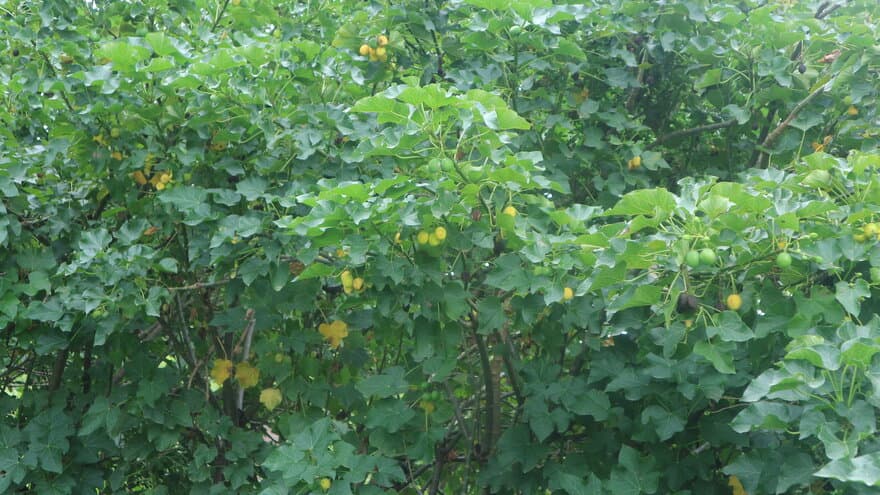The doctoral work of Yadessa Gonfa Keneni investigated the oil contents of jatropha (Jatropha curcas L.) seeds from different agro-climatic zones of Ethiopia and optimized biodiesel production process using reusable heterogenous catalysts and renewable alcohols. The results showed that the oil contents of different jatropha seed collections differed, and the oils can be used as the feedstock of biodiesel.
Energy is basic for development and its demand increases. Ethiopian national energy mainly depends on traditional biomass and imported fossil fuels, and the contribution of renewable energy is very small. Supplying the ever-growing energy demand with the entirely imported petroleum products puts high pressure on the foreign currency reserves of the country.
To reduce dependence on fossil fuels, Ethiopia designed the Biofuel Development and Utilization Strategy to increase fuel utilization efficiency and substitute fossil fuel demand by biofuel produced from renewable and locally available feedstocks. Accordingly, jatropha, palm tree and castor bean were identified as the promising biodiesel bearing plants. However, research-based information concerning the biology and life cycle assessment of jatropha in Ethiopia and the available technologies that process and convert jatropha oil to biodiesel were limited. These uncertainties can be one of the reasons that investors are less attracted towards the cultivation of jatropha and its biodiesel production compared to what is expected by the government.
The methods of jatropha seed processing for oil extraction, oil extraction techniques used, and the technologies used to convert the oil to biodiesel may determine the quantity and quality of the oil and the cost of the final product. Therefore, the present thesis aimed at the investigations of easy and more affordable techniques of jatropha seed drying for oil extraction, efficient method of oil extraction, the oil contents of different seed collections and biodiesel production techniques using renewable alcohols and reusable heterogenous catalysts.
Thirteen jatropha seed collections at storage moisture contents were dried in a heating furnace at different temperatures for oil extraction, and the drying kinetics was modeled. The seeds were extracted with four different solvents using cotton or extraction thimbles as filter and the oils were analyzed for selected quality parameters. Renewable alcohols (ethanol and 1-butanol) and reusable heterogenous catalysts (the anion ion exchange resin Amberlyst A26-OH and glycerol enriched non-calcined CaO) were used for biodiesel production and the reaction processes were optimized by employing Statgraphics, version 17 using response surface methodology.
The results showed that drying the whole seeds (without crushing) at 80oC reduced the moisture content of the seeds to its minimum which is suitable for oil extraction using solvents. The drying mathematical model that best fit to the drying kinetics of the seeds was also identified. From the oil extraction experiments, the most efficient solvent in terms of the percentage oil extracted was determined. Two seed collections with the highest oil contents were also identified. The result of the oil analysis showed that the oils can be used for biodiesel production as they fulfill the quality standards. The oil conversion and biodiesel yield obtained at optimum reaction conditions using anion exchange resin was higher compared to the previous studies, but the results need upgrading using integrating reaction factors. Biodiesel yield higher than 95% was obtained at the optimum reaction conditions using glycerol enriched non- calcined CaO as catalyst using butanol. Based on the results obtained, the thesis concluded that the oil contents of different jatropha seed collections differed, and the oils can be used as the feedstock of biodiesel.
I believe that the current research has presented at least three issues that have not been done in the previous studies on jatropha seeds and demonstrated new information to the academic discipline.
i) It determined a mathematical model that best fitted to drying kinetics of jatropha seeds at storage moisture content,
ii) Anion ion exchange resin, Amberlyst A26-OH, was used as catalyst in the transesterification of jatropha oil using ethanol, and
iii) Glycerol enriched non-calcined CaO was used as a catalyst in the transesterification of jatropha oil using butanol and obtained higher butyl ester yield (95%) at the optimum conditions.
Moreover, the results of this thesis can be used as the source of research based information for the research centers and universities working on jatropha seed oil extraction and biodiesel production in Ethiopia and other countries.
